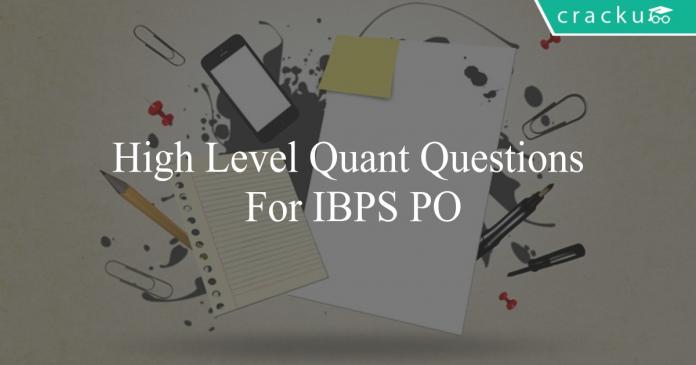High Level Quant Questions For IBPS PO
Download important High Level Questions PDF based on previously asked questions in IBPS PO and other MBA exams. Practice High Level questions and answers for IBPS PO exam.
Download High Level Quant Questions For IBPS PO
Take a free mock test for IBPS PO
Download IBPS PO Previous Papers PDF
Question 1: What is the last digit of the sum $131^{23}+147^{45}+153^{52}+139^{32}$ ?
a) 0
b) 1
c) 7
d) 6
e) 4
Instructions
There are 450 students in a college. Each student has to choose one or more elective out of management, history and physics. Further following information is also known –
1) 75 students selected only management and physics.
2) 84 students selected only management and history.
3) 52 students selected only physics and history.
4) The number of students who selected only history is 137 less the number of students who selected only management.
5) In total 238 students selected management as an elective.
6) In total 240 students selected history as an elective.
Question 2: How many students selected both management and physics as elective?
a) 84
b) 107
c) 75
d) 89
e) 98
Instructions
In each of the following questions a question is asked followed by three statements.You have to study the questions and all the given three statements and all the statements and decide whether any information provided in the statement are redundant and can be dispensed with while answering the questions ?
Question 3: what is the area of the given right angle triangle ?
I. Length of the hypotenuse is 5 cm
II.perimeter of the triangle is four times its base
III. one of the angles of the triangle is 60 degrees
a) I only
b) II only
c) II or III only
d) II and III both
e) Data inadequate
IBPS PO Quant Formulas & Shortcuts
Question 4: A train running at speed of 120 kmph crosses a signal in 15 seconds .What is the length of the train in meters?
a) 300
b) 200
c) 500
d) Cannot determined
e) None of these
Question 5: Rs 2520 is distributed among W,X,Y and Z and W:X=3:5, X:Y=7:8 ,Y:Z =4:3 then what is the share of X ?
a) Rs.700
b) Rs.420
c) Rs.800
d) Rs.600
e) None of these
Instructions
Compare the values and select the correct option.
Question 6: X:$x^{2}+4x-221$=0
Y:$y^{2}+36y+323$=0
a) X < Y
b) X > Y
c) X $\geq$ Y
d) X $\leq$ Y
e) X = Y or they cannot be compared
Question 7: A shopkeeper buys a dozen fruits for Rs. 3. At what price must he sell the fruits if he wants to realize a profit of 20 %?
a) 9 fruits for 30 rupees
b) 6 fruits for 15 rupees
c) 10 fruits for 6 rupees.
d) 90 fruits for 30 rupees
e) 50 fruits for 15 rupees
Question 8: What is the probability of selecting a number from 1 to 100 which is divisible by either 2 or 3 ?
a) 0.83
b) 0.67
c) 0.81
d) 0.33
e) 0.50
Instructions
What comes in the place of the ?
Question 9: 6,35,143,323,?
a) 391
b) 567
c) 609
d) 437
e) 667
IBPS PO Previous Papers (Download Pdf)
Question 10: A work can be finished In 14 days by 36 workers. If the work were to be finished in 8 days, how many additional workers would be required ?
a) 29
b) 33
c) 23
d) 31
e) 27
Question 11: A is 60% more efficient than B. In how many days will A and B together complete a piece of work if A alone can complete the work in 15 days?
a) $9\frac{7}{13}$
b) $8\frac{9}{13}$
c) $8\frac{4}{13}$
d) $10\frac{1}{13}$
e) $9\frac{3}{13}$
Question 12: A and B together can complete a particular task in 8 days. If B alone can complete the same task in 10 days, how many days will A take to complete the task if he works alone?
a) 28
b) 36
c) 40
d) 32
e) None of these
Question 13: For equation 2a + 5b = 108 find the number of pairs of positive integers a and b that satisfy this equation?
a) 15
b) 8
c) 10
d) 12
e) 9
Question 14: P starts business with Rs. 55000 and after 4 months, Q joins with P as his partner. After a year, the profit is divided in the ratio 5:4. What is Q’s capital contribution?
a) Rs. 76000
b) Rs. 80000
c) Rs. 75000
d) Rs. 66000
e) Rs. 60000
Instructions
Question 15: Compound interest on a certain sum of money for 3 years at a rate of $16\dfrac{2}{3}$% is Rs 12700. What is the simple interest on the same sum of money,same time period and same rate of interest ?
a) Rs.11200
b) Rs.10200
c) Rs.10400
d) Rs.10800
e) Rs.10000
Question 16: A shopkeeper wants to buy a rod of certain length such that he can measure 140 cm, 420 cm and 280 cm precisely. What is the maximum possible length of the rod that the shopkeeper can buy?
a) 70 cm
b) 140 cm
c) 35 cm
d) 7 cm
e) 20 cm
Question 17: If two sides of a triangle are 6 cm and 4 cm then how many integral values are possible for the third side ?
a) 6
b) 7
c) 8
d) 9
e) 10
Instructions
In each of the questions below consists of a question and two statements numbered I and II given below it. You have to decide whether the data provided in the statements are sufficient to answer the question. Read both the statements and
Give answer
(A) If the data in statement I alone are sufficient to answer the question, while the data in statement II alone are not sufficient to answer the question
(B) If the data in statement II alone are sufficient to answer the question, while the data in statement I alone are not sufficient to answer the question
(C) If the data either in statement I alone or in statement II alone are sufficient to answer the question
(D) If the data given in both statements I and II together are not sufficient to answer the question and
(E) If the data in both statements I and II together are necessary to answer the question.
Question 18: What is the area of right angle triangle ?
I.Height of right-angled triangle is ¾ th of its base
II.Length of the diagonal of the right angle triangle is 5 meters
a) If the data in statement I alone are sufficient to answer the question, while the data in statement
b) If the data in statement II alone are sufficient to answer the question, while the data in statement
c) If the data either in statement I alone or in statement II alone are sufficient to answer the question
d) If the data given in both statements I and II together are not sufficient to answer the question and
e) If the data in both statements I and II together are necessary to answer the question.
Instructions
Study the following table and answer the questions that follow. Some values are missing. You need to calculate them as per given information.

Question 19: If the average marks of B and D in Maths is 102.5, then find the average marks of all the students in Maths?
a) 93.5
b) 87.65
c) 97
d) 102
e) Can’t be determined
Instructions
Calculate the quantity I and the quantity II on the basis of the given information then compare them and answer the following questions accordingly.
Question 20: Quantity I: Find the units digit of $9562^{2469}$.
Quantity II: Find the units digit of $2567^{5242}$.
a) Quantity I > Quantity II
b) Quantity I < Quantity II
c) Quantity I $\geq$ Quantity II
d) Quantity I $\leq$ Quantity II
e) Quantity I = Quantity II or The relationship between Quantity I and Quantity II cannot be established.
IBPS PO Important Questions PDF
Free Banking Study Material (15,000 Solved Questions
Answers & Solutions:
1) Answer (A)
In the given terms $131^{23}$ has 1 in the units digit as any power which has 1 in units digit will return 1 in units digit.
$147^{45}$ has 7 in its units place and we have 7,9,3 and 1 as the power cycle of 7 and 45 when divided by 4 gives 1 as the remainder and so units digit will be $7^1 = 7$
$153^{52}$ has 3 in units place and power cycle of 3 has 3,9,7 and 1 and so when 52 is divided by 4 we have 0 as remainder and so units digit will be 1
$139^{32}$ has 9 in its units place and its power cycle has only 9 and 1 and so when 32 is divided by 2 we have 0 as remainder therefore units digit is 1
Therefore units digit of $131^{23}+147^{45}+153^{52}+139^{32}$ is 1+7+1+1=10.
Units digit = 0.
2) Answer (E)
Let ‘x’ be the number of students who took all the three electives and ‘y’ be the number of students who took only management as an elective.
We get following venn diagram –

Considering students who took management as an elective we have,
y + x + 84 + 75 = 238
x + y = 79
Considering students who took history as an elective we have,
137 – y + x + 84 + 52 = 240
y – x = 33
Adding both the equation we get,
2y = 112
y = 56
So, x = 23
So, number of students who took all the three electives = 23
Number of students who took only management = 56
Number of students who took only history = 137 – 56 = 81
So, the number of students who took only physics = 450 – 240 – 56 – 75 = 79
Thus, we get following venn diagram –

Number of students who selected both management and physics as elective = 75 + 23 = 98
Hence, option E is the correct choice.
3) Answer (B)
To find the area of right angled triangle, we need to know the base and height or the length of any side if its a 30-60-90 triangle
From statement I and III, two angles are 90° and 60°, => Third angle = 30°
In a 30-60-90 triangle, the hypotenuse is always twice as long as the side opposite the 30° angle and the side opposite the 60° angle is √3 times as long as the side opposite the 30° angle.
The ratio of sides opposite 30°, 60° and 90° angles =1 : $\sqrt{3}$ : 2
Length of the side opposite the 90° angle (hypotenuse) = 5 cm
=> Length of side opposite the 30° angle = $\frac{5}{2}=2.5$ cm
and length of side opposite to 60° angle = $2.5 \sqrt{3}$ cm
$\therefore$ Area of triangle = $\frac{1}{2} \times 2.5 \times 2.5 \sqrt{3} = 3.125\sqrt{3}$ $cm^2$
Thus, statement II is redundant.
=> Ans – (B)
4) Answer (C)
Speed of train = 120 kmph
= $(120 \times \frac{5}{18})$ m/s = $\frac{100}{3}$ m/s
Let length of the train = $l$ meters
Using, speed = distance/time
=> $\frac{100}{3} = \frac{l}{15}$
=> $l=\frac{100}{3} \times 15$
=> $l=100 \times 5=500$ meters
=> Ans – (C)
5) Answer (A)
Given W:X=3:5
X:Y=7:8
W:X=21:35
X:Y=35:40
W:X:Y=21:35:40
Y:Z=4:3
Y:Z=40:30
W:X:Y:Z=21:35:40:30
Given total share is Rs 2520
Share of X is $\dfrac{35}{126}\times2520$
= Rs.700
6) Answer (C)
$x^{2}+4x-221$=0
$x^{2}-13x+17x-221$=0
x(x-13)+17(x-13)=0
(x+17)(x-13)=0
x=-17 and x=13
$y^{2}+36y+323$=0
$y^{2}+17y+19y+323$=0
y(y+17)+19(y+17)=0
(y+19)(y+17)=0
y=-19 and y=-17
So X is either greater or equal to Y
7) Answer (E)
Cost price of a fruit = 3/12 = Rs. 0.25
Selling price = 1.2*0.25 = Rs.0.3
Let us check the options one by one.
9 fruits/ 30 rupees => Cost of 1 fruit = 30/9 = Rs.3.33
6 fruits/15 rupees => Cost of 1 fruit = 15/6 = Rs. 2.5
10 fruits/ 6 rupees => Cost of 1 fruit = 6/10 = Rs. 0.6
90 fruits/30 rupees => Cost of 1 fruit = 30/90 = Rs. 0.33
50 fruits/ 15 rupees => Cost of 1 fruit = 15/50 = Rs. 0.3
Therefore, option E is the right answer.
8) Answer (B)
we have 100/2 =50 numbers that are divisible by 2 in the first 100 numbers
Similarly 100/3 =33 numbers divisible by 3 in the first 100 numbers
But both of them have some numbers and they are repeated twice so the LCM of 2 and 3 is 6
100/6 =16 multiples of 6 are present in first 100 and so they are to be subtracted from them i.e
50+33-16=67
Therefore required probability = 67/100 = 0.67.
9) Answer (E)
here in this question given is the product of two consecutive prime numbers
i.e 6=2*3
35=5*7
143=11*13
323=17*19
667=23*29
10) Answer (E)
Using the formula, $M_1 D_1 = M_2 D_2$
=> $36 \times 14 = M_2 \times 8$
=> $M_2 = \frac{36 \times 14}{8} = 63$
$\therefore$ Additional workers = 63 – 36 = 27
11) Answer (E)
Time taken by A alone = 15 days
Efficiency of A : B = 100 : 160
= 15 : 24
=> Time taken by B = 24 days
$\therefore$ (A + B)’s 1 day’s work
= $\frac{1}{15} + \frac{1}{24}$
= $\frac{8 + 5}{120} = \frac{13}{120}$
$\therefore$ Required time = $\frac{1}{\frac{13}{120}}$
= $\frac{120}{13} = 9\frac{3}{13}$ days
12) Answer (C)
Let the total work to be done = 40 units
Rate at which B alone finishes the task = $\frac{40}{10}$ = 4 units/day
Rate at which A & B together finishes the work = $\frac{40}{8}$ = 5 units/day
=> Rate at which A alone finishes the work = 5 – 4 = 1 units/day
$\therefore$ Time taken by A to complete the task = $\frac{40}{1}$ = 40 days
13) Answer (C)
2a + 5b = 108
108 – 5b = 2a
We have to get an even number by subtracting a multiple of 5 from 108. So b must be an even number.
There are 21 multiple of 5 below 108. Out of those 11 are odd, and 10 are even.
For only 10 even multiples will get subtraction as an even number.
So b = 2, 4, 6, …, 20
Hence, option C is the right answer.
14) Answer (D)
Let Q contribute Rs. x
We have $\frac{55000*12}{x*8} = \frac{5}{4}$
x = Rs. 66000
Hence, option D is the right choice.
15) Answer (D)
We have
$P((1+\dfrac{r}{100})^{3}-1)=12700$
$P((1+\dfrac{50}{300})^{3}-1)=12700$
$P((1+\dfrac{1}{6})^{3}-1)=12700$
$P(127/216)=12700$
$P=21600$
We have P=Rs.21600 R=50/3% t=3 years
SI=$\dfrac{21600\times50\times3}{100\times3}$
= Rs.10800
16) Answer (B)
The lengths 140 cm, 280 cm and 420 cm should be the multiples of the length of the rod. The maximum possible length of the rod will be equal to the HCF of these 3 numbers.
140 = 2*70
280 = 4*70
420 = 6*70
As we can see, the HCF is 2*70 = 140 cm.
Therefore, option B is the right answer.
17) Answer (B)
For a triangle to form the sum of two sides should be greater than the third side and the difference of two sides should be less than the third side
Therefore (6+4)>s>(6-4)
10>s>2
So all the values between 2 and 10 are possible as third side
i.e 3,4,5,6,7,8 and 9
Therefore 7 values are possible
18) Answer (E)
I : Let base of the triangle = $4x$ m
=> Height of triangle = $\frac{3}{4} \times 4x = 3x$ m
There is no other info, so I alone is insufficient.
Similarly, II alone is also insufficient.
Combining both statements, and using pythagoras theorem, we get :
=> $(3x)^2 + (4x)^2 = (5^2)$
=> $9x^2 + 16x^2 = 25$
=> $x^2 = \frac{25}{25} = 1$
=> $x = \sqrt{1} = 1$
=> Base = 4 m and height = 3 m
$\therefore$ Area of triangle = $\frac{1}{2} \times 3 \times 4 = 6 m^2$
Thus, both statements together are sufficient.
19) Answer (C)
Given, average marks of B and D in Maths is 102.5
Then, Total marks obtained by B and D in Maths = 205.
Marks obtained by A in Maths = 46.67% of 150 = $\dfrac{7}{15}\times150 = 70$
Marks obtained by C in Maths = 66.67% of 150 = $\dfrac{2}{3}\times150 = 100$
Marks obtained by E in Maths = 73.33% of 150 = $\dfrac{11}{15}\times150 = 110$
Therefore, Required average = $\dfrac{70+100+110+205}{5} = \dfrac{485}{5} = 97$
20) Answer (B)
Quantity I:
Units digit of $9562^{2469}$ = Units digit of $2^{2469}$
$2^1 = 2$
$2^2 = 4$
$2^3 = 8$
$2^4 = 16$. Units digit = 6
$2^5 = 32$. Units digit = 2
Hence, The cyclicity of 2 is 4.
Dividing 2469 by 4, we get a remainder of 1.
Hence, The units digit of $2^{2469}$ = Units digit of $2^1 = 2$
Quantity II:
Units digit of $2567^{5242}$ = Units digit of $7^{5242}$
$7^1 = 7$
$7^2 = 49$. Units digit → 9.
$7^3 = 343$. Units digit → 3.
$7^4 = 2401$. Units digit → 1.
$7^5 = 16807$. Units digit → 7.
Hence, The cyclicity of 7 is 4.
Dividing 5242 by 4, we get a remainder of 2.
Hence, The units digit of $7^{5242}$ = Units digit of $7^2 = 9$
Therefore, Quantity I < Quantity II





